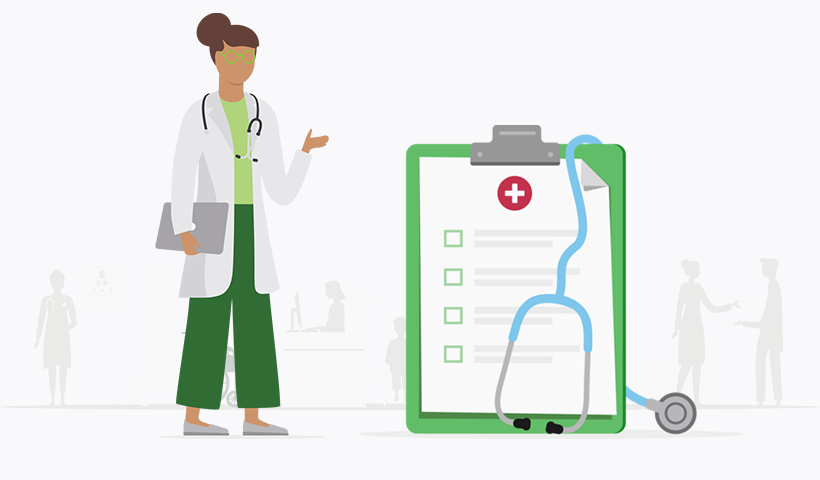When managing healthcare records, the terms EMR and EHR are often used interchangeably. However, understanding the difference between EMR and EHR is crucial for effective healthcare print management and ensuring seamless patient care.

Understanding EMR and EHR
What is EMR?
Electronic Medical Records (EMRs) are digital versions of paper charts used by clinicians to record patient information such as medical history, diagnoses, medications, and test results. EMRs are primarily used within a single healthcare practice for diagnosis and treatment.
What is EHR?
Electronic Health Records (EHRs) are comprehensive digital records of a patient’s medical history that include information from multiple healthcare providers, hospitals, labs, and pharmacies. EHRs are designed to be shared across different healthcare settings, enabling real-time access to patient information.
Benefits and challenges of EMR and EHR
Benefits of EMR and EHR
- Improve patient care: EMRs and EHRs provide access to complete and accurate information, enabling better decision-making and coordination of care.
- Streamline workflows: They reduce paperwork, duplication, and errors, saving time, space, and resources.
- Increase accuracy and security: They minimize human errors and protect data from unauthorized access.
- Comply with healthcare regulations: They meet standards like HIPAA for the privacy and security of health information.

Challenges of EMR and EHR
- Interoperability: Ensuring different systems communicate and exchange data can be hindered by technical, organizational, or legal barriers.
- Data privacy and security: Protecting sensitive health information from unauthorized access is crucial and often threatened by cyberattacks, human errors, or natural disasters.
- System integration: Connecting different systems to work together is complicated by legacy systems or hardware lock-ins.
- User adoption: Acceptance and use by healthcare professionals and patients can be limited by resistance to change, lack of training, or poor user experience.
How can healthcare print management help with these challenges?
Read how PaperCut works in an Epic environment
Read how PaperCut works in a Cerner environment
Print monitoring and tracking
Healthcare print management involves monitoring and tracking printing activities across devices, locations, users, or departments. This helps identify printing patterns, optimize resources, allocate costs, and enforce rules.
Secure print release
Secure print release ensures that documents are only printed when the user is present to authenticate the job. This prevents unauthorized access, reduces paper waste, and allows for convenient printing from any device.
Mobile printing
Mobile printing enables healthcare professionals to print patient records and other documents from their smartphones or tablets. This improves productivity, flexibility, and accessibility, especially when printing from cloud-based services.
Print rules and policies
Setting up print rules and policies based on criteria like device type, location, user role, or document type helps reduce costs and improve security. For instance, limiting color printing and enforcing duplex printing can save resources.
Fax integrations
Integrating faxing with print management solutions allows healthcare providers to securely transmit confidential patient data. This centralizes access to EMR and EHR for staff, ensuring efficient and secure document handling.
Best practices for healthcare print management
Implement a comprehensive print management strategy
Once you have a solution, conduct a printing assessment that examines your organization’s needs, spending, consumption, and physical footprint. Many organizations don’t realize they have printing problems until they look closer at their print environment.
Opening the lid on your printing will identify current printing challenges and future opportunities. Then your organization can design a print management strategy that aligns with objectives and budgets that includes a clear vision, goals, metrics, roles, and responsibilities for managing printing activities across the organization.
Train staff on secure printing practices
Print security isn’t at the forefront of our minds when we think of IT security. Education on secure printing basics is one of the first places to start when exploring print management for EMR and EHR.
Regular training and education on secure printing practices for healthcare staff help them understand how to protect printed health information from unauthorized access or disclosure, and how to comply with HIPAA regulations and other policies.
Regularly audit print processes to identify areas for improvement
Auditing print jobs, print processes, print performance, and print behavior is key to understanding the story of your organization’s printing. You can only fine-tune your printing environment by purposefully monitoring and measuring their printing activities, costs, and outcomes.
Baptist Health Care (BHC) in Florida solves secures printing and achieves superior compliance with PaperCut MF
Baptist Health Care (BHC) in Florida is comprised of three hospitals, four medical parks, and 7,000+ print users. They implemented PaperCut MF as their healthcare print management software to secure and streamline their printing of patient records.
“In the health industry, privacy’s everything, so that was a key factor in selecting a print management system.”
- Kenny Stranger, System administrator, Baptist Health Care
By using PaperCut features such as Secure Print Release and Find-Me printing BHC improved their security to comply with regulations, provided a simple and convenient workflow, and delivered considerable savings: “There were millions saved,” says Kenny.
“PaperCut’s the superior choice in my opinion. The balance between security and cost-saving is a real benefit.”
- Kenny Stranger, System administrator, Baptist Health Care
Read the full customer story.
READ MOREEnhancing EMR and EHR with print management software
EMR and EHR are essential tools for modern healthcare practice, and printing is naturally part of that record-keeping equation.
Healthcare print management solutions can help healthcare organizations overcome the challenges of EMR and EHR and ensure secure and efficient printing of patient records, reducing printing costs and waste, and complying with security regulations like HIPAA.
Find out more about PaperCut software for healthcare.
DISCOVER MOREFAQs
What is EMR?
EMR stands for Electronic Medical Records, which are digital versions of paper charts used within a single healthcare practice.
What is EHR?
EHR stands for Electronic Health Records, which are comprehensive digital records including information from multiple healthcare providers.
What is the difference between EMR and EHR?
EMR is used for diagnosis and treatment within one practice, while EHR includes all patient health information and is shared across multiple providers.
How does healthcare print management help with EMR and EHR?
Healthcare print management ensures secure and efficient printing of patient records, reduces costs, and helps comply with regulations like HIPAA.




